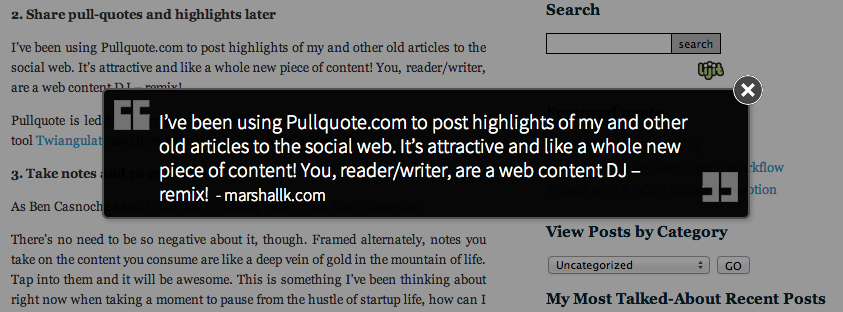I just mentioned an old blog post of mine in an email to someone and thought, “hey I should repost that out on Twitter.” Titled How to Quit Your Day Job and Become a Professional Tech Blogger, it’s getting a bunch of retweets again, 3 years after I wrote it, on a rainy Saturday morning.
Here are three ways I’ve been experimenting with getting more value out of old content, whether it’s mine or someone else’s, whether it’s 1 day old or 3 years.
1. If you share it in an email or mention it to a friend, other people might like to see it too
I was telling my co-worker Shelby La Croix about this article “9 Things Successful People Do Differently” yesterday too, for example, and may as well re-share it publicly elsewhere. It’s still really good.
The river of news online plus our linear conception of time might conspire to lead us to believe that old content is inevitably forgotten, but just like time travelers we can loop back into the past and return to the present with gems for use in building the future!
2. Share pull-quotes and highlights later
I’ve been using Pullquote.com to post highlights of my and other old articles to the social web. It’s attractive and like a whole new piece of content! You, reader/writer, are a web content DJ – remix!
Pullquote is led by Henry Copeland, who also built the fabulous Twitter analysis tool Twiangulate and invested in Little Bird (thanks Henry!).

3. Take notes and re-read them
As Ben Casnocha says, If You Aren’t Taking Notes, You Aren’t Learning.
There’s no need to be so negative about it, though. Framed alternately, notes you take on the content you consume are like a deep vein of gold in the mountain of life. Tap into them and it will be awesome. This is something I’ve been thinking about right now when taking a moment to pause from the hustle of startup life, how can I get into a regular habit of taking and re-reading notes? I’m trying to use Evernote files tagged Notes. It is so wonderful when I do. It’s like a combination of Harold Jarche’s Personal Knowledge Management and renaissance man Robin Sloan’s Fish. (“Look at the fish!” I often tell myself.)
I sure do love the Internet. May you get loads and loads of goodness from it, old and new!